Where to go in Switzerland on a short trip: Alps, lakes, and cities
Switzerland is an extremely popular country for those planning multi-stop tours around Europe, yet very few potential first-time visitors actually know specifically where they want to go. Everyone seems to know that it has the most beautiful views of the Alps and some very impressive cities, but there are actually many misconceptions among casual trip planners, so I’d like to clear most of that up below. The places to visit in Switzerland are not obvious until you’ve been there yourself or done many hours of research, so the list below should be a short cut.
I get hundreds if not thousands of itinerary questions for people who are considering a Eurail trip around Europe, and most people just include the word “Switzerland” among a list of cities like Paris, Rome, and Berlin that they want to visit. So where in Switzerland should you go if you can only make a few stops at most? I’ll answer that question below. You’ll mostly want to focus on the best choices for Swiss Alps trips, which I’ll go over below.
Note: This article was expanded and updated in February, 2024.
Switzerland is about outdoor views rather than city visits
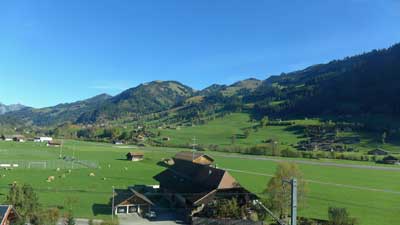
Geneva is a very famous city (though not for tourism reasons) on a lovely lake of the same name, but it’s also notoriously dull and lacking distinction. Rick Steves puts it well by saying that “Geneva is pleasantly situated on a lake, like Buffalo or Cleveland.” The point is, you don’t want to go to Geneva unless you’ve got something specific in mind that you want to see there. There are much better places to visit in Switzerland if your time is limited, or even if it’s not.
Switzerland's cities in summary
Zurich – The largest city, very expensive, geared towards business travelers. It’s generally a pretty and very well-run city that you would enjoy if you visited, but it’s not nearly as interesting as the likes of Vienna, Munich, or of course Paris.
Geneva – Second largest city, in the French part of the country, no major sights. Again, if you visited you’d be very impressed by it and get some great photos, but it’s not worth your time unless you know someone there. There’s an impressive fountain in the lake and you can usually see it from the train as you go through the city, but it’s not really worth going there and staying more than an hour or so.
Basel – Bordering France and Germany, no major sights. It has the famous art market each year, and aside from that it’s even duller than the ones above. Again, if you visited you’d be impressed, but if you later compared photos with friends who went to the Lauterbrunnen Valley instead, you’d kick yourself for going to Basel.
Lausanne – Near Geneva in the French part of the country, very hilly, and certainly more interesting than Geneva.
Bern – The capital, compact, on a lovely river, some interesting sights and the best Swiss city to get a feel for the culture. Bern is fairly close to Interlaken (which we will discuss below) and it can be a great day trip from there, especially on a day where it is foggy and/or rainy in the mountains (and this happens a LOT).
How much time and which Swiss cities to visit?
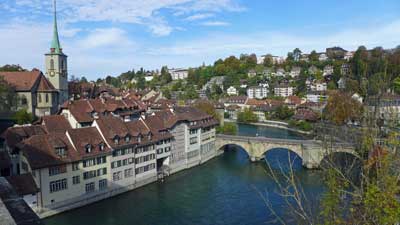
Many people (me included) don’t feel as if they’ve scratched the surface of a new country if they haven’t spent at least a day or two in the largest city. Zurich is certainly pleasant and a useful transit hub so spending one or two nights there wouldn’t be a major mistake. But Zurich isn’t even close to being a city like Paris, Rome, Berlin, Amsterdam, or even Vienna. If you skip it in favor of spending more time in the Swiss Alps, you won’t be missing much.
The 2 Best places to visit in Switzerland for short visits
Interlaken – If you want the best possible Alpine views and activities, head to the Interlaken area, which will be described in detail below. This is my favorite of all places to visit in Switzerland and it will probably be yours as well.
Lucerne – The traditional Swiss tourist retreat, Lucerne is a small city with interesting culture and sights, that is gorgeously set on a lake with plenty of top activities surrounding it.
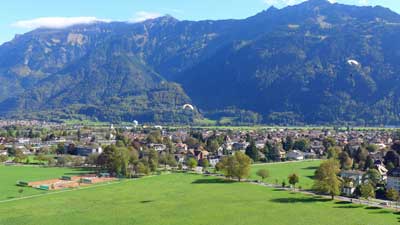
>>>Interlaken and Lucerne: Which to choose and how long to stay in each?
The article linked above will give you more details on which to choose and how long to spend in each place.
What about Zermatt for Alpine views?
Zermatt is a remote car-free village in southern Switzerland that is famous for being the place to see the Matterhorn mountain. It’s also a busy ski resort area, and aside from that, there isn’t much to see or do here. It’s on a private rail line, so it’s more complicated and usually more expensive to reach than Interlaken.
In other words, unless you’ve irrationally placed “Seeing the Matterhorn in person” on your so-called bucket list, skip Zermatt and head to Interlaken on a shorter visit. You won’t be sorry. If you already have enough time in your visit for the main sights around Interlaken and Lucerne and you want to also see the Matterhorn, then by all means go and you’ll enjoy it. There are quite a few other car-free villages in the Lauterbrunnen Valley near Interlaken, so they are not as novel in Switzerland as one might expect.
A weekend in Switzerland? What to see in 3 days
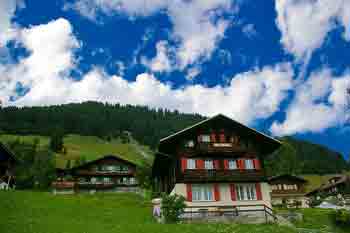
One challenge is that neither has an international airport so you’ll either be flying into Zurich or perhaps Geneva.
Train times from Zurich to Lucerne to Interlaken and back
- Zurich Airport to Lucerne: 1 hour 10 minutes by train
- Lucerne to Interlaken: 2 hours by train
- Interlaken to Zurich Airport: 2 hours 15 minutes by train
As you can see with the travel times above, Zurich Airport to Lucerne is a fairly short trip, but once you add Interlaken into the mix (even if you skip Lucerne) the travel time starts to add up for a weekend visit. With this in mind it’s probably best to just choose one of them and save the other one for another trip.
Lucerne is gorgeous, but the Lauterbrunnen Valley near Interlaken is really the star of the show, so I’d recommend going there first and doing Lucerne on another trip.
What about the Swiss Travel Pass?

The bottom line is that if you are coming to Switzerland for at least 3 days and you want to take 2 or more of the amazing scenic rail journeys that the country is famous for, the travel pass is probably a good deal. It also provides 50% discounts on the Schilthorn cable car and 25% off the Jungfraujoch mountain railway. Both of those are quite expensive on their own, but extremely worthwhile, so the discount is helpful.
The Half Fare Card is probably a better deal for most people
The Swiss Travel Pass is a good deal for those who are going to be spending at least 2 or 3 days riding the rails and seeing Switzerland that way. But if you are mostly going to be focusing on Interlaken and Lucerne and the mountain sights, the Half Fare Card is the best option. For CHF120 (about US$134) you get the card that is good for 30 days and gives you a 50% discount on all trains, cable cars, mountain railways, and other sights and attractions. If you are doing either Schilthorn or Jungfraujoch, the Half Fare Card practically pays for itself with just one of those.
>>>Buy the Swiss Half Fare Card
Many people have questions about the Swiss Half Fare Card so I will explain it a bit here. You can actually buy half price train tickets for travel within Switzerland any time you want and you will see that option when you go to buy them online. The only thing is you have to have and present a valid Half Fare Card when you get on the train and are asked to see your ticket. In other words, you can buy a half fare train ticket today and buy a Half Fare Card just before you get on that train months in the future, and you are fine.
How and why visit the area around Interlaken
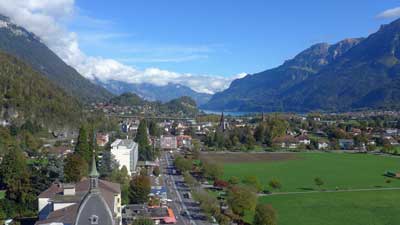
You can see everything discussed below by actually staying in a hotel in Interlaken, but it’s not the Alpine experience that you get if you stay in one of the small villages nearby. You can reach those villages in 20 to 40 minutes from the Interlaken Ost (East) train station, and it’s much easier than it sounds.
The 3 best places to stay to visit the Swiss Alps
Lauterbrunnen – A private train line runs from Interlaken Ost station to the end of its line in Lauterbrunnen. There’s a lovely waterfall here and great hiking trails, but you should probably only stay here if you can’t get to one of the villages mentioned just below. It’s a great little transit hub and it’s definitely gorgeous, so it can be worth a night if you’ve got one to spare.
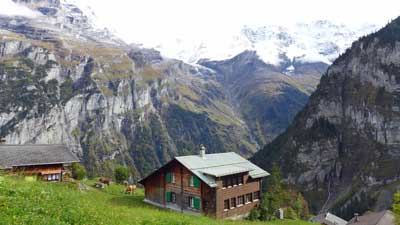
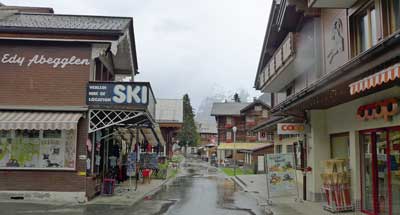
Where to stay in Interlaken and the Lauterbrunnen Valley (with pics)
I get so many questions about where to stay in the Interlaken area that I decided to write a longer version of it and load it with huge photos so readers can get a better feel for each option. I also included recommendations for affordable and well-located photos in each area.
>>>Where to stay in Interlaken and the Lauterbrunnen Valley New for 2024!
The unforgettable things to see here (if the weather is decent)
Schilthorn observation deck and restaurant
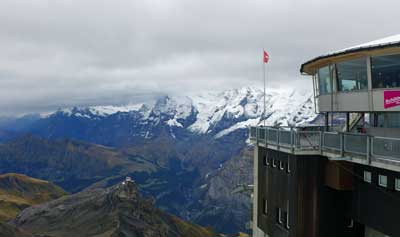
There is a rotating restaurant (with prices similar to normal Swiss restaurants) and a bizarre and anachronistic James Bond attraction based on it being a key location in the 1969 movie On Her Majesty’s Secret Service. The Bond thing is included with the lift, and it’s worth a look.
But the main thing you come here for is the 360-degree view from one of the highest peaks in Europe. Again, the weather here is key, but fortunately all the locals track the visibility on a minute-by-minute basis. If it’s clear up top while you are in the area, it would be a terrible shame to skip it based on the high price. But even if it’s cloudy up top, there are still plenty of wonderful things to see and do in the villages below.
Jungfraujoch observation area
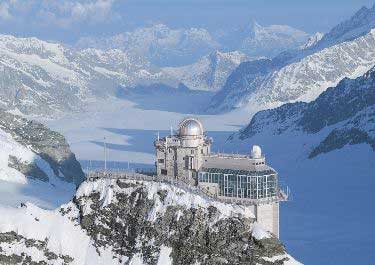
The views from the top are similar to the views from Schilthorn, from the other side of the Lauterbrunnen Valley. Once on top you can have lunch, hike, or even go sledding. It’s also quite expensive at nearly US$200 round-trip unless you have a Swiss Pass or a Eurail Pass for discounts, and it takes most of your day, but you’ll never forget the views from the top.
Harder Kulm mountain and Two Lakes Bridge Observation Deck
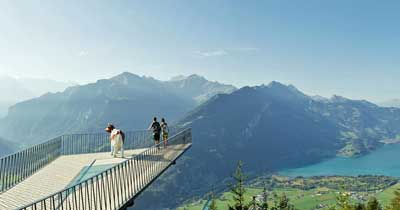
There’s a revolving restaurant about 10 minutes’ walk from the station at the top, which is definitely an unforgettable place for lunch if you’ve got time. It’s not as expensive as you might expect, at least compared to normal restaurants in Switzerland.
The Harder Kulm Railway goes from early April through late November each year. If you are only in Interlaken for one day and/or you are on a strict budget, this is the fastest and best way to get amazing Alpine views in the area.
Getting from Interlaken to Gimmelwald and Mürren
Getting up to these villages sounds complicated and time consuming, but it’s actually fast and easy once you get there. This little guide should help.
Arrive in Interlaken
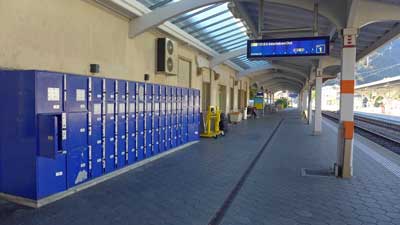
Once you arrive at the Interlaken Ost train station, head for the ticket windows in the office and buy a ticket to your final destination (Lauterbrunnen, Gimmelwald, or Mürren). Eurail passes are good for 25% discounts on the rest of the trip, but not for the whole thing.
From Interlaken Ost to Lauterbrunnen
The private train leaves Interlaken Ost every 30 minutes and arrives in Lauterbrunnen 20 minutes later. If you are staying in Lauterbrunnen then you are probably walking distance from your hotel when you reach the station.
From Lauterbrunnen to Gimmelwald
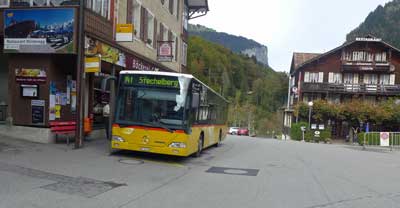

From
Gimmelwald to Mürren
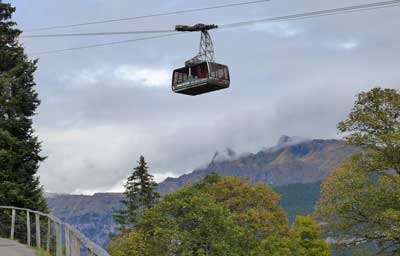
Recommended hotel and hostel in Gimmelwald
I get asked all the time about where to stay in Gimmelwald, so here it is:
Hotel: Esther’s Guesthouse
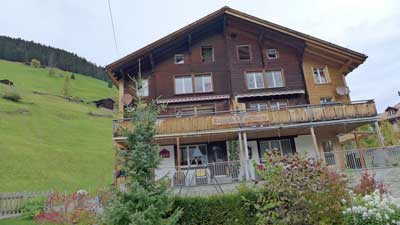
It’s run by Esther, as you might guess, and she is very friendly speaking excellent English. Each room is different and the place feels like a mountain cabin, because it is. She offers an excellent buffet breakfast in the morning, which you have to order the night before. It’s not cheap, but it’s worth it because it’s hearty and there are no other good options nearby.
Book as early as possible because this place is often the first place to sell out in Gimmelwald.
Hostel: Mountain Hostel Gimmelwald
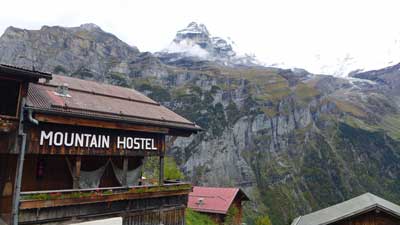
You won’t believe the views from this place, which are the same as from Esther’s except a bit lower and more unobstructed. This place also has a busy bar and restaurant that is basically the only “nightlife” in Gimmelwald. Many hikers get to bed early in this tiny village, but if you want to have a couple drinks and order a pizza or some local options, this is the place to go.
Again, book early because this place is always sold out.
Lucerne and what to do there
Luzern, as it’s spelled locally, is the other traditional holiday destination in Switzerland. Unlike Interlaken, Lucerne actually qualifies as a small city rather than a small resort town, so it’s a very nice contrast and very worthwhile. We have a new article with advice on where to stay in Lucerne and it should be helpful.
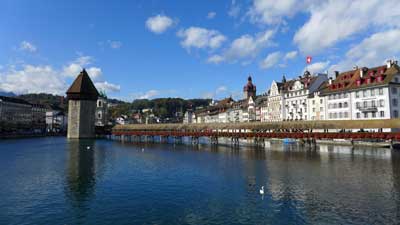
However, unlike Interlaken, the town of Lucerne itself is a great attraction and worth at least a day of exploration. This has always been a rich area so you can expect to find all of the high-end shops and boutiques along the small streets just north of the lake, but there are also many traditional shops and things to see that will appeal to anyone.
Recommended hotel in Lucerne
>>Hotel Des Alpes (3 stars with an amazing location and view)

If this place is booked, which is often the case, then book a hotel as close to it as you can find or afford. The whole historic part of town surrounding it is lovely, with restaurants, bars, and high-end shops. There are also a couple of nearby supermarkets where you can buy inexpensive alcohol and picnic supplies to keep other costs down.
Spend a day in Lucerne itself
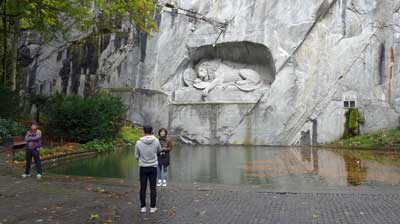
Most of the interesting part of Lucerne is in the area behind those restaurants, and it’s certainly worth doing a self-guided walking tour if not a guided one. Heading farther east you’ll come to another older part of town where the famous lion statue is located. You can’t visit Lucerne without having a look at the lion, and fortunately it’s easy and quick to reach (and it’s free).
Take a lake cruise of some kind
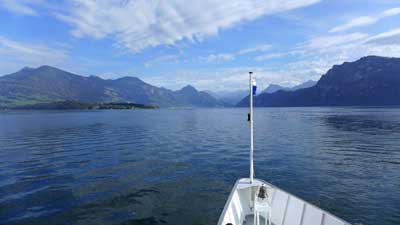
Especially in nice weather, even the short lake tour is lovely, and if you have more time you can jump off at Vitznau and do the scenic hike up Mount Rigi. There are also small lakeside villages that are ideal for a stroll and lunch stop. Long story short, there are dozens of interesting sightseeing options that are available using part of the boat tour, and the views all around are wonderful.
Visit Mount Pilatus
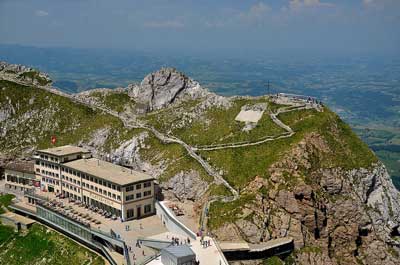
You can take the cogwheel train up and have a more or less flat hike around the summit area, and then take the gondola and cable car back down again. You can do them in the other order, and the cost is the same either way. At around US$65, this is not a cheap hike, but like most everything in Switzerland, the quality is high so it doesn’t feel like a rip-off. You can reach the cable car in 10 minutes on a public trolly bus from Lucerne.
Visit Mount Rigi
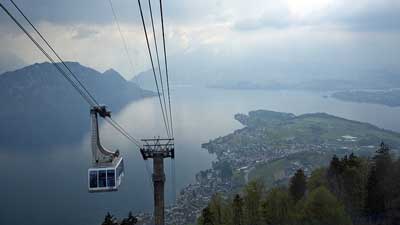
Unlike the other peaks mentioned in this article the Swiss Travel Pass covers both ways to get up and down for free. The others are 50% off with the Swiss Travel Pass or Half Fare Card, except for Jungfraujoch, which is only 25% off with the Swiss Travel Pass and still 50% off with the Half Fare Card.
Visit Mount Titlis
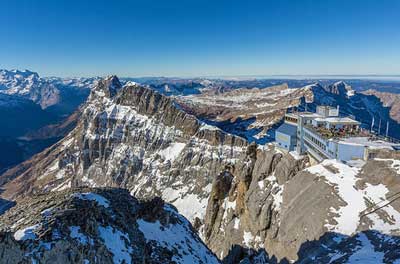
You can reach Titlis by taking a 43-minute train ride from Lucerne to Engelburg and then taking the cable car up from there. As with the others, it’s wise to check the weather immediately before you are going to depart because it can be foggy or cloudy any time of the year, but usually not for whole days at a time.
Additional photo credits
Jungfraujoch by cupweuro on Flickr, Pilatus by Tony Fernandez on Flickr, Rigi by Kosala Bandara on Flickr, Titlis by PaulSchliebs on Flickr

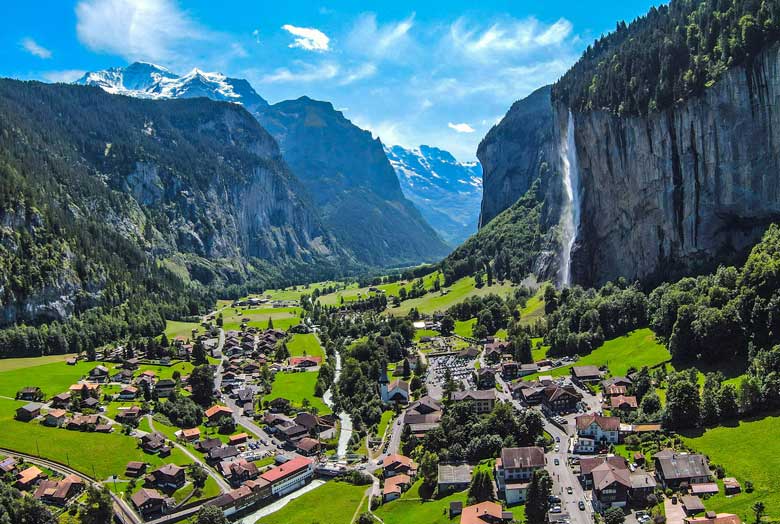
Hi Roger
Thanks for all the valuable information you provided. I’m planning a trip to Switzerland in June and have a rough itinerary in mind. Would appreciate your input. We are 2 adults and like walking around, trying to keep costs economical.
Sunday June 11 Land in Zurich around 11.35am (from Toronto via London)
Train Zurich to Interlaken 50 CHF
Overnight in Interlaken
Monday June 12 Visit Bern for day trip capital of Switzerland Interlaken to Bern train 28 CHF
Bern to Interlaken 28 CHF
Overnight in Interlaken
Tuesday June 13 Go to Lake Brienz cost ?
After lake trip go to Gimmelwald or Murren walk around
Schilthorn Cable Car 105 CHF
Overnight Gimmewald or Murren depending on where we get accomodation
Wed June 14 Jungfraujoch railway from Interlaken 205 CHF
Overnight Gimmewald or Murren depending on where we get accomodation
Thursday June 15 Interlaken to Lucerne train 33 CHF
Tour around city Lucerne and tour the Lake
Overnight Lucerne
Friday June 16 Possibly do Mt. Pilatus
Don’t really have a plan. Any ideas will be appreciated?
Overnight Lucerne
Saturday June 17 Lucerne to Zurich train 25 CHF
Tour around Zurich
Overnight Zurich
Sunday June 18 Fly out of Zurich 9.35am to Toronto
I have some questions based on the above intinerary
1.Can Bern be done on June 11 or is it too much traveling? If not is the lake the better option to do on June 11
2.Can Bern and Lake Brienz be done on June 12
3.Is it ok to skip Lake Brienz if we are doing lake trip on Lucerne
4.Should I do another area besides Interlaken and Lucerne?
5.Based on the above I think I should get the half fare card. Do you agree? Of if not is there a better option I can take?
6.Should I add a scenic train trip? Or the ones I’m taking enough?
7. How is the weather in June? Do I need hiking boots or running shoes okay to walk around/light hikes around Murren/Gimmewald
Thanks in advance!
Marie,
I’ll try to answer your questions in order…
1. If you land in Zurich just before noon, and you are going to sleep in Interlaken, I don’t think you’ll have the time and energy to tour Bern on that same day.
2. Yes, you should be able to visit Bern and also Lake Brienz on the same day. Bern is quite small and you can walk from the train station to the historic center in maybe 10 minutes. Within 4 hours or so you’ve seen all the main highlights, and you can head out after that.
3. The Lucerne boat trips are different than Lake Brienz, and probably more dramatic as well. But if you have time to do both I think you’d enjoy both. Maybe leave Lake Brienz only if you have the energy on that day?
4. If you do the main sights around Interlaken and Lucerne and also do a day trip to Bern, you’ve seen the best of Switzerland. I don’t think you need to go anywhere else.
5. Yes, the Half Fare Card will save you a LOT of money on this trip, and it would be a better deal than the Swiss Travel Pass.
6. The train trips you are already taking will all be very scenic, so I don’t think you need to add one of the famous ones.
7. The summer months are also the rainy months in the Alps, but the weather patterns move quickly and often it’ll be raining in the morning and then clear the rest of the day. You just have to keep on top of the forecast once you get there because people say it can change if it’s more than 2 days away in the forecast. But the towns where you’ll be staying will be fairly warm. It’s the high altitudes where it gets cold, even in June. The trails through Murren and Gimmelwald are fully paved, but since you might encounter some wet periods, I think bringing hiking boots could be worthwhile. You won’t need a heavy boot, and really anything with grips on the bottom should work. Have a great trip. -Roger
Hi Roger,
Thanks so much for running such a lovely blog and diligently/selflessly answering everyone’s queries. Your blog is wonderful and am sure will be the main reason why my trip to Switzerland is going to be one of the most memorable ones.
We are a couple travelling with a 4year old for 10 days from India, and I wanted to run you past my itinerary and seek your suggestions.
Day 1: Arrive in Zurich at 7am – Zurich city tour, evening and night stay at Lucerne ( lake side)
Day 2: Lucerne : Lake cruise, Mt. Pilatus ; stay overnight
Day 3: Lucerne to Gimmelwald: Schilthorn tour, Murren tour; night stay at Gimmelwald
Day 4: Gimmelwald to Interlaken : Lauterbrunnen tour; stay at Interlaken
Day 5: Day tour to Bern ; stay at Interlaken
Day 6: Interlaken to Innsbruck ; via Liechtenstein
Day 7: Innsbruck to Salzberg; night stay at Salzberg
Day 8: Visit nearby villages; night stay at Salzberg
Day 9: Salzberg to Prague;
Day 10: Leisure around in Prague; need to research??
Day 11: Fly out from Prague at 9 AM
Need help with the following
1. Is my itinerary too loaded for a 4 yr old? Should I drop Liechtenstein from the itinerary?
2. Would I be able to move from Lucerne to Gimmelwald and cover Schilthorn tour, all in a day?
3. Do you think I should add a day more somewhere? Where would you recommend? Although this would be tough/ or drop something?
4. Austria and Czech would be better than Italy right? ( P.S. I have only been to UK and Turkey in Europe)
5. Would you recommend driving down from Interlaken to Innsbruck? I am planning to take the bus right now
My apologies for taking the liberty to ask so many questions. Thanks so much for your help
Cheers,
Kunal
Kunal,
Thank you for the kind words. I do think your itinerary might be fairly busy for a 4-year-old. On the other hand, all of the things on your list are very popular and well organized, so it’s not like your child will have to walk for hours. It will be short walks and very good public transportation.
I’d drop Liechtenstein from your trip, and probably Innsbruck as well. From what I’ve seen and heard, Liechtenstein isn’t even an interesting part of the little valley that it’s in, and the only reason to go there is to be able to say you’ve been there. As for Innsbruck, it’s okay, but it’s really more of a skiing and snow boarding town with very few sights. Unless there is something specific you want to see or do there, I’d skip it. Salzburg is wonderful though. Prague is quite a large city so maybe that extra day there?
Your first few days will be busy, but it shouldn’t be strenuous. After that it looks like you are slowing down a bit, so I think it will work well.
From Lucerne to Interlaken it’s about 2 hours by train. From Interlaken Ost train station to the top of Schilthorn it takes about 2 more hours, and then two hours back down. If you spend only an hour or two, which is typical, on top of Schilthorn, you can do it all in one day starting in Lucerne. Hopefully the weather up there is clear that day because if it’s not then it’s really not worth going.
I’d just skip Liechtenstein and Innsbruck and add that day to Prague so you have two full days there. I wouldn’t add anything else.
Comparing Austria and Czechia to Italy is tough. Italy has the most sights in Europe, but most of the top destinations (Venice, Florence, Rome) are very crowded. It’s probably better to save Italy for a whole future trip and do what you have planned here this time.
I’d take the train whenever possible, since it’s faster and more comfortable than buses. The train is probably also more expensive, so a bus can save some money. But I’d check the time tables and see how much longer the bus would take. Switzerland’s train system is legendary and very punctual, so even though it’s expensive at least you get a lot for your money. Let me know if you have any other questions. -Roger
And I’ve global Euro rail pass for travelling Europe train. How much that pass can help me in reducing my travel cost. Which pass will be beneficial for me considering my travel plans to roam around Gimmewald, Interlaken and possibly Lucerne. Will I be able to manage more scenic rail trips around in the given time.
Ashish,
If you are referring to the normal Eurail Pass, it will help a lot. It will cover all of your normal train rides between cities, but it only gives a 25% to 50% discount on the mountain trains starting from Interlaken such as to Lauterbrunnen or all the way to Jungfraujoch. A Eurail Pass also gets you a 50% discount on the cable cars, such as to Schilthorn.
If you want to do any of the scenic trains with the panorama carriages, you’ll need to pay a supplement for those special seats. But that’s true of the Swiss Travel Pass as well. So a Eurail Pass does cover most transportation, but not all of the private attractions in the mountain peak areas. -Roger
Hi Rogers,
I’m planning a trip to Switzerland for 3 days from July 15th. I’ll enter Switzerland from Baden-Baden on 15th morning and will go straight to Gimmewald. I’ve booked pension hotel in Gimmewlad for 2 nights. I’m planning cable car trip around Gimmewald and some sight scenes.On the third day, I’ve hotel booking in Interlaken. On Fourth day morning, I’ll take a train to Rome. My extended family including 4 adults and 3 children (age 1, 3 & 8) will accompany me on the trip. Can you please help me out for finalising the day to day itenary For the three day trip.
Ashish,
I’d get the Half Fare Card for Switzerland, which should pay for itself pretty quickly. Staying in Gimmelwald is wonderful, and the obvious thing to do is Schilthorn (mentioned in the article above), which is at the top of the series of cable cars that Gimmelwald is on. If the weather up top is clear, hop on the cable car and you’ll never forget the scenery at the top.
On the other day you might consider Jungfraujoch, which is the other major mountain sight in the Interlaken area. It’s more expensive than Schilthorn and it takes about 6 hours, but it’s worth it if the weather up there is nice and you have the Half Fare Card. There are many other sights and hikes and scenic viewpoints in the Interlaken area. You can take a train from Lauterbrunnen to Wengen and then after a short walk through town you can hop on a fairly cheap cable car that takes you up the mountain there. On top you have a restaurant and many hiking paths, and most of them are level or walking downhill from there, so they are easy. You probably also want to walk around Interlaken itself for a few hours. You’ll have no problem finding good things to do with all of your time there. -Roger
Hi Roger,
I am planning a trip in first week of august with my wife from London to Paris and then to switzerland. I found your article and I am planning to follow what you in switzerland however I am not sure what should I do in 4-5 days. Below is what I thought:
Day1-3 — in Paris
Day3- Paris to Interlaken. explore interlaken.
Day4- Interlaken to jungfraujouch.
Day5- Interlaken to Lucern. Explore the city.
Day6- Boat tour and return to zurich.
I can stay more in switzerland but I cant find more places to visit.
do you think I should visit all schilthorn, jungfraujoch, rigi & Pilatus. I was planning to only cover jungfraujoch.
please suggest if I should cover rhine falls as well.
Thanks in advance.
Krish,
I think your plan looks really good as you have it. All of those mountain-top sights are amazing and different from one another, but they are also quite expensive. I’d say that if you can afford them and the weather happens to be good during your whole visit, then do all of them that you can. Those are the views you’ll never forget.
I just added a section about the Half Fare Card to the article above, which I would recommend for you. Jungfrau and Schilthorn are quite expensive without it, so the 50% discount pays for itself quickly.
However, I don’t think I’d recommend doing more than one of those peak attractions in a day. Jungfrau takes maybe 6 hours and the others are more like 4 to 5 hours each. Trying to do two in one day would mean rushing around and not being able to enjoy the general scenery. I haven’t been to the Rhine Falls, but it looks really good as well. Switzerland is packed with top sights, and I’m sure you’ll be able to fill all of your time there and still wish you could stay another day or two. Let me know if you have any other questions. -Roger
Hi Roger,
Thank you for your reply. I have generally made out my plan, that is:
Day 1, arrive in Zurich airport at 9:30 morning, travel to Lucerne directly, staying for two night.
Day 2, Lucerne area and lake cruise (Lake Luzern, Chapel Bridge, Water Tower, Lion Monument and Mt. Pilatus)
Day 3, Mt. Titlis. Evening transfer to Interlaken/ Grindelwald using Golden Express. Night stay at Grindelwals
Day 4, interlaken area in morning, then travel to Bern and stay for a night
Day 5, travel back to Zurich, return flight on 9:30 night.
However, for the staying in Lucerne, which neighborhood would you recommend, with stunning view and convenience transport transit.
Do you have any recommendations for my plan? Regarding to attractions and activities?
Thank you so much, cheers.
Aaron
Aaron,
I mention in the article above the hotel and area I recommend in Lucerne. If you have a hotel with views of the Chapel Bridge, you are in the best spot. Those hotels can be expensive though. Really, any hotel that is reasonably close to the train station is good. The lake boats leave from a dock right in front of the train station, so that is the transport hub. The area south of the lake is a little rougher and the area north of the lake is a posh shopping area, but it’s all safe and close.
Your overall plan looks fantastic. I added some text about the Half Fare Card to the article above, and it seems like your best bet. -Roger
Hi Roger,
I am planning to solo travel to Switzerland in the middle of June, would like to visit places like Zurich, Lucerne, Interlaken, Gimmelwald and Bern. I am on a tight budget of GBP 400 for a 4/5 days trip, that is excluded the air ticket. I personally would prefer amazing nature views like mountain, snow, and lake, than cities.
However, I could not decide whether a Swiss pass would be worth for my trip. I planned to go for 1 lake cruise, 1 scenic rail, and if there is anything u would recommend, I would be highly appreciated.
Next, could you suggest a travel itinerary? (where would be best for staying overnight, and what would be the ‘must not miss activities’)
Thank you so much. Cheers.
Aaron,
Your budget is going to make this tough. Switzerland is an amazing country for sightseeing and nearly everyone agrees that it’s worth the splurge, but things cost MUCH more than even in neighboring France, Austria, and Germany. Zurich itself is ludicrously expensive and it’s not that interesting, so I’d maybe spend a day there and sleep somewhere else.
There are hostels in all of the places you mention, and a famous hostel with possibly the most amazing location of any hostel in the world called the Mountain Hostel in Gimmelwald. But it’s not cheap either. I think a Half Fare Card would be better value for you than a Swiss Travel Pass, and they are both discussed in my article on the Swiss Pass. Even with the Half Fare Card, the train rides between those cities will add up as well.
I normally don’t like to type out itineraries for people, although I don’t mind helping people tweak the ones they have done themselves. For you I’d suggest finding hostels that you can afford and staying in Interlaken or Gimmelwald for 2 or 3 days and Lucerne for the other days. Bern is a really nice city, but if you aren’t into cities you might just skip it and save the expense. The lake cruise on Lucerne isn’t too expensive and it’s very nice. All of the train trips between those places are very scenic, and from Interlaken to Lucerne is even part of the Golden Pass. If you can afford another scenic rail trip you might take the rest of the Golden Pass to the west towards Montreaux, as it goes through an extremely scenic valley. If you can afford Schilthorn and the weather is decent at that time, you won’t regret it. With the Half Fare Card it’s definitely worthwhile. Let me know if you have any other questions. -Roger
big thank you ;0)
Wonderful article!!! i am planning a trip to Interlaken in mid September. Planning in landing in Zurich from Los Angeles. Can you recommend a website I can purchase my train tickets from to take us from Zurich to Interlaken? Should I buy them ahead of time to save money or buy them day of? Do you know the approximate cost of a one way ticket to Interlaken from Zurich?
From Interlaken we will go as you recommended to Gimmelwald and Murren stay 2 nights. From there we would like to enter Italy (Milan). What would you recommend we take as transportation from Interlaken to Milan?
Also How much could i expect to pay to get from Interlaken to Gimmelwald?
Sorry, last question…would you recommend me top over in lucerne first, for one dday, before I make it to Interlaken? Would it be cost effective with the train ticket pricing?
Michelle,
I just saw your new question on this version. From Zurich to Lucerne it’s CHF26 and then from Lucerne to Interlaken it’s another CHF33, so it’s a bit more expensive to stop in Lucerne on the way. But it’s worth it if you have the time. -Roger
Hi Roger,
Wonderful article!!! i am planning a trip to Interlaken in mid September. Planning in landing in Zurich from Los Angeles. Can you recommend a website I can purchase my train tickets from to take us from Zurich to Interlaken? Should I buy them ahead of time to save money or buy them day of? Do you know the approximate cost of a one way ticket to Interlaken from Zurich?
From Interlaken we will go as you recommended to Gimmelwald and Murren stay 2 nights. From there we would like to enter Italy (Milan). What would you recommend we take as transportation from Interlaken to Milan?
Also How much could i expect to pay to get from Interlaken to Gimmelwald?